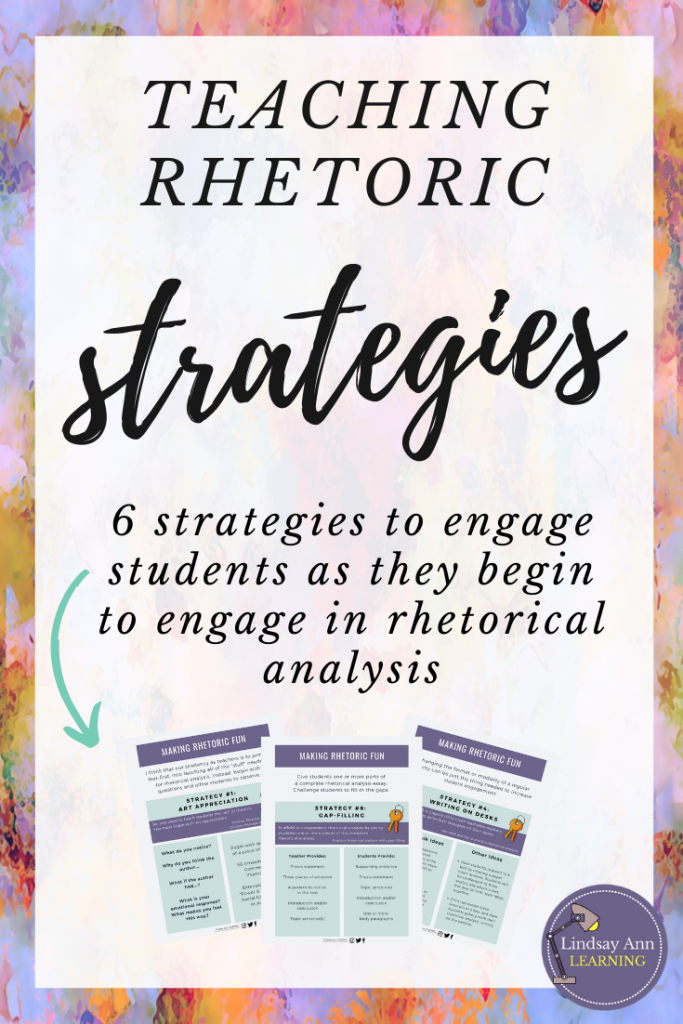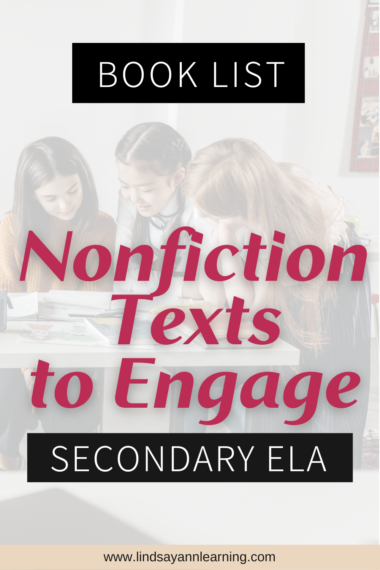


Before we get to the rhetorical analysis essay prompts (a.k.a. tons of ready-to-analyze texts at your fingertips), let’s take a time-out to lay the groundwork for understanding a rhetorical analysis essay using ethos, pathos, and logos.
Put simply, rhetoric refers to any technique an author uses to persuade an audience.
Or, the behind-the-scenes choices an author makes to give you all the feels.
Chances are, if you consider a text or speech to be really good, rhetorical techniques are working like a master puppeteer to pull at your heart strings, make an impact on your brain, and get you to let down your guard because you trust the author or speaker.
That’s why political figures have speech writers.
That’s why authors spend time fine-tuning their words and sentences.
Rhetoric is important.
In addition, rhetoric goes back to the ancient Greek philosophers like Aristotle, the “father” of rhetoric.

Moving on, if rhetoric is the art of persuasion, then the rhetorical analysis essay analyzes how an author or speaker creates opportunity for persuasion in his/her text.
Writing a rhetorical analysis essay involves understanding of context and occasion for writing. It also involves understanding the subject matter of the speech and intended audience.
Beyond this, noticing how the author uses rhetorical appeals and rhetorical devices to impact the target audience can help you to write an in-depth rhetorical essay analysis.

As a teacher, I’m always in search of engaging texts for students to analyze. In this post, I’m sharing the best speeches, advertisements, and essays for rhetorical analysis. You’ll never run out of rhetorical analysis essay topics again!
So, you’ll definitely want to stop right now and pin this post.
Your future English-teacher-self will thank you.
The following speeches work well individually, but I’ve also tried to add value by pairing texts together.
Whether you’re analyzing rhetorical appeals such as ethos, pathos, and logos or looking at rhetorical devices, these speeches will work for discussion or as the text for a rhetorical analysis essay.

This next list holds a blend of print advertisements and commercials, perfect for introducing close reading and rhetorical analysis and for writing a rhetorical analysis essay.
Ads are short, but pack a punch. Honestly, my students love analyzing the rhetoric of advertisements a lot because they are accessible and visual.
No doubt, writing a rhetorical analysis essay is like taking apart a puzzle and putting it back together again. Teachers, help your students to understand how all of the pieces fit together in order to see the bigger picture of what the author is trying to accomplish.
First, take time to understand how a text “works” for a rhetorical analysis essay using ethos, pathos, and logos:
Look for rhetorical devices & patterns in the text.
Finally, write a clear thesis statement & topic sentences for your rhetorical analysis essay.
I’ve created an awesome free guide to inspire English teachers who teach rhetoric and the rhetorical analysis essay in their classrooms. Even if you don’t teach AP lang, you can benefit from these strategies!

Writing a rhetorical analysis essay is like writing a literary analysis essay, except the focus is on one or more non-fiction texts and the analysis targets an author’s style or rhetorical “moves” (a.k.a. use of rhetorical appeals and/or devices). Rhetorical analysis essays usually prove a claim about the author’s message or purpose for writing. The paragraphs in a rhetorical analysis essay unpack “what” an author is doing to send this message and “how” these choices impact the audience.
Writing a rhetorical analysis means that you are aware, as an audience member, reader, listener, human being, of the messages you consume. As a critical consumer of others’ ideas, you ask hard questions about how these messages are shaped, why they’re being delivered in certain ways, and why this is important for you and for society.
The three most commonly known rhetorical strategies are known as rhetorical appeals. Ethos (ethics) refers to credibility and trustworthiness. Pathos (passion) refers to engaging an audience’s emotions. Logos (logic) refers to engaging an audience’s brain through logical organization and use of evidence and arguments.
Sharing is caring!
Lindsay has been teaching high school English in the burbs of Chicago for 19 years. She is passionate about helping English teachers find balance in their lives and teaching practice through practical feedback strategies and student-led learning strategies. She also geeks out about literary analysis, inquiry-based learning, and classroom technology integration. When Lindsay is not teaching, she enjoys playing with her two kids, running, and getting lost in a good book.
You may be interested in these posts from the same category.












Hi Lindsay Ann, thanks so much for these great resources. Just wanted to gently point out a couple errors that you might want to fix: #12: should be Seth Myers’ (not Seth Myer’s)
#13: should be independence (not independance) Teachers have to help each other out 🙂 Best,
Nikkee
[…] a lot of options and extensions for analyzing rhetoric in social media. Who knows, maybe your next rhetorical analysis essay assignment will be focused on rhetoric in social […]
Ultimate Guide to Teaching Podcasting | English Teacher Blog says: […] 70 Rhetorical Analysis Essay Topics for Secondary ELA […] Teaching Voice in Writing Made Simple | Lindsay Ann Learning says:[…] find that teaching rhetorical analysis and close reading skills go hand-in-hand with teaching voice in […]
Can You Pass the Ethos, Pathos, Logos Definition Test? | Lindsay Ann Learning says:[…] helps students to remember that everything comes back to the author’s purpose or message in rhetorical analysis. Author’s purpose is central to unpacking an author’s choices, including use of […]
Rhetorical Analysis Sentence Starters: Easy and Effective! | English Teacher Blog says:[…] you assigning a rhetorical analysis essay? Why not try having students use rhetorical analysis sentence […]
Free Rhetorical Analysis Unit | huffenglish.com says:[…] I introduced students to rhetoric. First, we journaled on this topic: Think of a time someone talked you into doing something or believing something. How did they do it? What tactics did they use? Students may share out journals. I gave students a graphic organizer with a PAPA analysis (purpose, audience, persona, argument) and picked a speech. Frankly, the speech I picked, which was Samwise Gamgee’s speech to Frodo Baggins in The Two Towers, failed spectacularly since students had no frame of reference. Note: that movie is old now. I know. It makes me sad, too. So go cautiously if you use this, but maybe pick something else. You can find a massive list here. […]
This site uses Akismet to reduce spam. Learn how your comment data is processed.
I’ve created a FREE guide with 20 of my best strategies for streamlined grading to help English teachers like you have more time to do what you love.